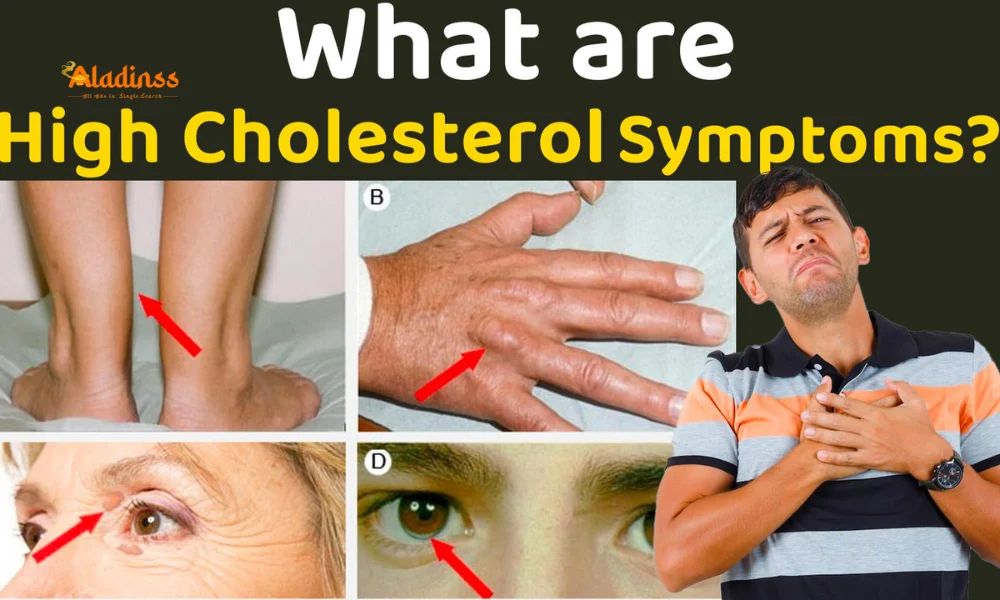3 Silent High Cholesterol Symptoms You Might Be Missing

3 Silent High Cholesterol Symptoms You Might Be Missing
High cholesterol is often called the "silent killer" because it builds up in your arteries without obvious signs, increasing the risk of heart disease and stroke. In India, where cardiovascular issues are a leading health concern, spotting subtle symptoms can be life-saving. From unexplained fatigue to yellowish bumps near your eyes, these overlooked signs may indicate high cholesterol levels. This World Health Day, we explore three silent symptoms, their implications, and why early action is critical for heart health, especially for Indian adults balancing busy lives and diverse diets.

Yellow Bumps Near Your Eyes: A Hidden Warning
Noticed soft, yellowish bumps around your eyelids or near your joints? Known as xanthelasma palpebrarum, these are more than cosmetic quirks. These small cholesterol deposits under the skin can signal elevated cholesterol levels, a red flag for heart health. In India, where skin concerns are often dismissed as aesthetic, recognizing xanthelasma as a potential warning sign is crucial.
Xanthelasma typically appears as flat or slightly raised patches, often near the inner corners of the upper eyelids. They’re painless, making them easy to ignore, but research suggests that about 50% of people with xanthelasma have high cholesterol or lipid disorders. Indian diets, often rich in fried foods like samosas or pakoras, can contribute to cholesterol buildup. If you spot these bumps, a lipid profile test, widely available at diagnostic centers, can confirm if cholesterol is an issue. Early detection allows you to manage levels through diet or lifestyle changes, reducing heart disease risk.
To address xanthelasma, focus on heart-healthy foods like oats, nuts, or leafy greens. Cutting back on processed snacks and incorporating daily walks can also help. These bumps are your body’s way of signaling trouble, so don’t overlook them, especially if heart disease runs in your family.
Persistent Fatigue: A Sign of Heart Strain
Feeling constantly exhausted, even after a full night’s sleep, is common in India’s fast-paced cities. While stress or overwork is often blamed, persistent fatigue can be a subtle high cholesterol symptom. When cholesterol narrows arteries, it restricts blood flow, forcing your heart to work harder. This reduced oxygen delivery can leave you feeling sluggish during routine activities like walking or climbing stairs.
In India, where sedentary lifestyles are on the rise, this symptom is frequently overlooked. Fatigue linked to high cholesterol may signal early atherosclerosis, where arteries harden due to plaque buildup. Studies suggest this reduced blood flow can cause unexplained tiredness, even in seemingly healthy individuals. For Indian adults juggling long commutes or desk jobs, this could be a critical warning. A lipid profile test can clarify if cholesterol is the cause, and most clinics offer it at affordable rates.
Combat fatigue by adding fiber-rich foods like lentils or vegetables to your diet and engaging in regular exercise, such as yoga or brisk walking. If tiredness persists, especially with a family history of heart issues, consult a doctor. Addressing cholesterol early can boost energy levels and prevent serious complications like heart attacks, which are increasingly common in India.
Mild Chest Discomfort: Your Heart’s Distress Signal
Experiencing mild tightness, pressure, or discomfort in your chest during activities like brisk walking or climbing stairs? This sensation, known as angina, is a critical high cholesterol symptom. It occurs when narrowed coronary arteries, often clogged by LDL cholesterol, limit oxygen-rich blood to the heart. In India, where heart disease is a leading cause of death, recognizing angina is vital for early intervention.
Angina may feel like squeezing or burning, often mistaken for indigestion or muscle strain. It typically appears during exertion and subsides with rest. Indian diets high in ghee or fried foods can contribute to LDL buildup, increasing angina risk. If you notice this symptom, especially with a family history of heart disease, a cholesterol test or ECG is essential. These tests are widely available and can guide treatment to prevent heart attacks.
To manage angina risk, reduce consumption of oily foods and incorporate heart-healthy options like whole grains or fruits. Regular physical activity, even 20 minutes of daily walking, can improve blood flow. If chest discomfort persists or worsens, seek medical attention immediately to avoid severe outcomes. Acting on this subtle sign can protect your heart and extend your quality of life.
Why High Cholesterol Goes Unnoticed in India
High cholesterol is a growing concern in India, where heart disease claims countless lives annually. The Indian diet, often rich in fried snacks, sweets, and processed foods, contributes to elevated LDL levels. Urbanization and sedentary lifestyles further amplify the risk, yet the silent nature of high cholesterol means symptoms like xanthelasma, fatigue, or angina are often ignored until a major health event occurs. In India, where healthcare access varies, awareness of these signs is critical.
Cultural factors, like a preference for rich, oily dishes, play a role in cholesterol issues. For example, frequent consumption of deep-fried items or creamy curries can elevate LDL levels over time. Many Indians only discover high cholesterol during routine check-ups or after a health scare. Regular screening, especially for those over 30 or with risk factors like diabetes, is essential. Lipid profile tests are affordable and available across urban and rural clinics, making early detection accessible.
Steps to Protect Your Heart Health
Recognizing silent high cholesterol symptoms is just the start—taking action is key. Begin with a lipid profile test to check your cholesterol levels. These tests are widely available and cost-effective, even in smaller cities. Adopt a heart-healthy diet with foods like oats, nuts, green vegetables, and whole grains like brown rice or millets. These are affordable and align with Indian culinary traditions, making them easy to incorporate into daily meals.
Limit fried foods and sugary drinks, which are common in Indian diets. Instead, opt for beverages like green tea, which supports heart health with its antioxidants. Regular exercise, such as brisk walking, yoga, or cycling, improves circulation and lowers cholesterol. For those with a family history of heart disease, consulting a cardiologist for personalized advice is wise. These consultations are accessible in most Indian cities and can guide long-term prevention strategies.
The Role of Awareness in Preventing Heart Disease
In India, heart disease is striking younger populations, with cases rising among those in their 30s and 40s. Awareness of silent symptoms like fatigue, xanthelasma, or angina can make a significant difference. Community health campaigns, especially during World Health Day, emphasize early detection and lifestyle changes. In rural areas, where access to advanced diagnostics may be limited, recognizing these signs can prompt timely visits to local clinics.
Education is key to breaking cultural habits that contribute to high cholesterol, such as over-reliance on oily foods. Simple swaps, like using olive oil instead of ghee or choosing grilled over fried snacks, can lower LDL levels. Schools and workplaces in India are increasingly promoting heart health through wellness programs, encouraging regular check-ups and balanced diets. By staying vigilant and acting on these subtle signs, Indians can reduce the burden of cardiovascular disease.
Integrating Heart-Healthy Habits into Indian Lifestyles
Adopting heart-healthy habits doesn’t require drastic changes. Start with small steps, like adding a serving of vegetables to every meal or walking 20 minutes daily. Indian staples like dal, roti, and sabzi are naturally heart-friendly when prepared with minimal oil. Avoiding processed foods, such as packaged snacks or sugary sweets, can also lower cholesterol risks. For busy professionals, preparing home-cooked meals with whole grains and lean proteins ensures better control over ingredients.
Community support, like joining local fitness groups or participating in health camps, can boost motivation. Many Indian cities offer free or low-cost yoga sessions, which improve circulation and reduce stress—a known contributor to heart issues. By making these habits part of daily life, you can address silent cholesterol symptoms and build a healthier future without overwhelming changes.
Comment / Reply From
No comments yet. Be the first to comment!






